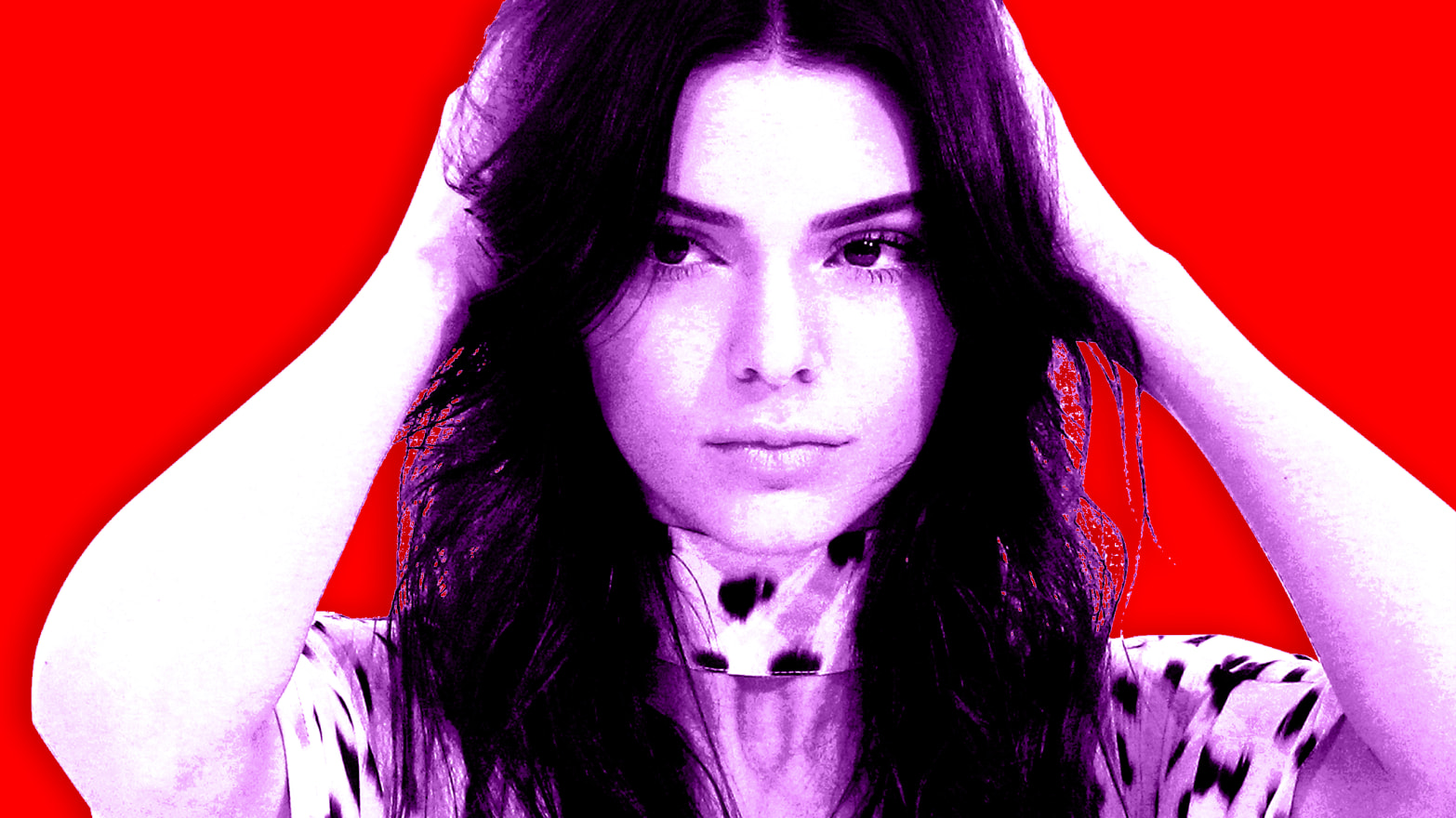In April 2017, a movement was born. Hordes of ethnically diverse millennials looked up from their brunches and noticed that something wasn’t right. Handfuls of informed citizens quickly became hundreds, and then thousands. Pulling off our proverbial blonde wigs, we took to the streets, finally, joyously united under one shared cause: the desire to totally and utterly drag Kendall Jenner.
If 2016 was Kylie Jenner’s year of realizing stuff, then 2017 is Kendall Jenner’s year of refusing to realize a damn thing. Not since Karlie Kloss said that “Waterfalls” was her favorite Beyoncé song has an Insta-model proven herself to be so profoundly out of touch. Jenner’s most spectacular recent mishap was her Pepsi commercial, a deeply flawed piece of advertising that ushered in KJ’s no good, very bad month.
Pepsi’s “Live for Now Moments Anthem,” starring Kendall Jenner and featuring “Lions” by Skip Marley, is more commonly known as “that fucking Pepsi ad” or “the one where Kendall Jenner discovers politics and makes a black girl hold her hair.” This delightfully disingenuous late capitalist confection imagines a protest so trendy that no one seems to have any idea what they’re protesting. Jenner, mid-photo shoot, throws off the chains of her professional responsibilities—here, represented by a blonde bob—to join the growing protest AKA sign party. It’s basically Coachella with poster boards. The commercial ends with Jenner, self-appointed resistance leader, addressing growing tensions between the protestors and the police by handing a cop a cool, refreshing Pepsi-Cola. This sequence, which appeared to pull its imagery directly from the confrontation between police officers and Black Lives Matter activist Ieshia Evans in Baton Rouge, immediately had viewers reaching for their Excedrin for Racial Tension Headaches.
Life proceeded to come at Kendall Jenner faster than it comes at a black person who forgets to bring a can of Pepsi to a protest. First, she was outed as Instagram-complicit in the disaster of Fyre Festival, a high-end music festival that quickly descended into Lord of the Flies-style chaos. While Jenner played no part in the planning or execution of the event—we’re sensing a pattern here—she did promote the Bahamian mis-adventure on her extremely popular Instagram. The revelation that Jenner received $250,000 just to advertise the festival in a single Instagram post predictably rubbed would be festival-goers the wrong way.
Last but not least, Jenner rounded out her April with a cover shoot for Vogue India. The Mario Testino-shot spread—a special edition marking Vogue India’s 10th anniversary—quickly came under fire, with readers asking why Jenner and her “Indian Affair” were chosen for this honor over an actual Indian celebrity. Criticism increased when savvy social media users realized that Jenner had failed to hype her new cover on Instagram, perhaps a sign that the model sees Vogue India as less prestigious than its American and European counterparts. This month, Jenner shared multiple Instagram posts about her new Harper’s Bazaar cover. Historically, she’s shared her appearances in American, Spanish, German, and Australian Vogue magazines. “She didn’t even post these pictures on her Instagram because it’s Vogue India. And you chose her as the cover model,” Instagram user Plein.de.viee said. Another user didn’t hold back, commenting, “This is so disappointing and disrespectful! Why was a white privileged girl who doesn't even deserve her fame chosen to represent india?”
The backlash was so severe that Vogue India posted a clarification, explaining that, “In the last 10 years, Vogue India has had only 12 international covers, including Kendall Jenner, in 2017. Therefore, statistically, 90 per cent of our covers are Indian! And we are proud of that.” The statement continued, “India has given the world so many beautiful faces to admire. After all, we are Vogue, an international brand, and we want to give the love back by featuring some of the best international celebrities on our covers. Occasionally!”
Like her other recent PR mishaps, Jenner’s Vogue India cover seems like a confluence of events—some of them out of Jenner’s control, some of them not—all culminating in a product that’s far more offensive than the sum of its parts. After all, Kendall Jenner poses for photoshoots for a living. Within the larger fashion photography genre of thin white women gallivanting through a foreign country in couture, this newest entry is relatively unremarkable. Jenner isn’t draped in traditional dress, covered in henna or sporting a bindi. She’s even joined by an Indian actor, Sushant Singh Rajput, for some of the shots—although, tellingly, Rajput didn’t make it onto the cover.
Of course, the issue here isn’t with Jenner or Testino’s execution, but the specific context they were working in; one that, like almost all contexts, Jenner seems painfully ignorant of.
Within any formerly colonized nation, the image of a pretty white woman having a brief dalliance with your country/culture—an “Indian Affair,” if you will— is sure to strike a chord. This tone-deaf casting is exacerbated by the special occasion of Vogue India’s 10th anniversary, which seems like the perfect opportunity to celebrate Indian influencers and South Asian beauty.
Instead, Vogue India’s editorial team decided that Kendall Jenner would be a more appealing cover model—a decision that reinforces centuries of punishing European standards of beauty. In a country where fair skin is still a valuable commodity, and whitening products are a drug store staple, highlighting darker-skinned beauty is an important undertaking. Indian women and girls deserve to be accurately reflected in media; if Vogue India expects to appeal to Indian readers, it ought to prioritize their experiences and skin tones. Models’ looks and body mass indexes have always been unattainable—a separate issue—but magazines can deal in aspirational images without reinforcing whiteness as a universal aspiration.
It’s easy to draw a line between Jenner’s misguided “Indian Affair” and her F-minus Ieshia Evans impression. In both of these instances, Jenner’s been cast in a role that was either originated by or rightfully belongs to a woman of color. The Vogue India 10th anniversary would have been an incredible opportunity to celebrate an Indian woman; instead, readers got a generic Kendall Jenner shoot that celebrated the model’s ability to pose dead-eyed on every single continent. The problem here is not with the work that Kendall Jenner does—modeling for magazines, endorsing products, and generally being tall and beautiful. Rather, it’s with her (or Kris Jenner’s) strange belief that Kendall Jenner is and can be the face of all things; a global supermodel, the voice (or at least the cheekbones) of her generation.
Kendall, it’s time for some tough love. When you and Gigi Hadid decided that having a certain number of Instagram followers made you the new Naomi Campbell, we let it slide. Replacing supermodels with insta-models seemed like a raw deal, but, hey, we’re living in a social media influencer-controlled hell of our own creation. Still, just because you’re one of the biggest faces in fashion today doesn’t mean you can, or should, take every single job. Kendall Jenner’s first crime is overexposure.
Of course, overexposure is a foreign crime for a Kardashian. The reality TV world’s first family has discovered a magical formula in which fame breeds even more fame. The Kardashians are everywhere because they’re everywhere. But Kendall Jenner’s miraculous exposure algorithm is somehow off, and her omnipresence has begun to annoy everyone from ballet enthusiasts to social justice warriors. In contrast, we don’t get exhausted when Kylie keeps coming up with new ways to sell ColourPop knock-offs. Khloé and Kourtney’s televised antics—10 percent pranks, 90 percent eating salads—never bore us. Even when a Kardashian is hit by a wave of backlash, she’s never torn asunder. So what, aside from her physical resemblance to a lightning rod, has made Kendall Jenner such a lightning rod?
The issue might be as simple as Jenner’s decision to hold an actual job as a model—the Kardashian equivalent of working nine to five. Whereas the other Kardashians have invented their careers, Jenner inserted herself into a delicate fashion ecosystem that existed long before the Kardashian era. The family generally stays in its unique, highly successful lane. You could never say that Kourtney Kardashian shouldn’t be selling $45 Fit Tea on her Instagram. If she didn’t, who else could we count on to give 56.8 million Instagram users a week’s worth of diarrhea? Meanwhile, Kendall can always be conceived of as stealing a gig from someone else, and her covers, runways, and commercials put her in front of a wide audience that isn’t necessarily enamored with the Kardashian empire.
But Jenner’s recent public image beat-down goes far deeper than the people who didn’t buy her modeling career from the get go. The fact is, these days, we’ve come to expect more, both from our major models and from the editorial teams and advertising agencies that employ them. This is a beautiful moment in internet history where celebrities can no longer get away with being insensitive or downright offensive. More accurately, someone who wears a bindi to Coachella might continue to reap the rewards of multi-million dollar contracts and international fame, but you can bet their Twitter mentions will be messy. I’m not saying that Kendall Jenner is going to start donating all of her appearance fees to Black Lives Matter because a stranger found the perfect sassy Real Housewives GIF to send to her in the wake of Pepsi-gate. But hey, Rome wasn’t built in a day, and Kendall Jenner won’t be cancelled in one either.
While Kendall Jenner’s brand of apoliticism may have guaranteed a universal appeal in the past, now individuality—in appearance and in personal beliefs—is becoming more and more of a marketable virtue. We’re slowly shifting into an era where standing for nothing is no longer the safe marketing decision. In fact, it can be downright infuriating. What made Pepsi’s commercial so ridiculous wasn’t just the casting of a white model amidst BLM-inspired imagery; it was the decision to hire a woman who has consistently failed to voice a strong opinion or engage in any political action.
Jenner doesn’t need to immediately go out and get herself a set of progressive causes and a bullhorn. But if she wants to get back on the public’s good side, coming to terms with her own whiteness seems like a great place to start. The Kardashian family, on a whole, has consistently failed to acknowledge that they are white women who have profited from black trends and physical attributes that have long been associated with blackness. Kendall Jenner is a white woman and, shocking as it may seem, that might very well disqualify her from certain jobs.
Jenner’s consistent refusal to reckon with her racial identity in the work that she does makes her a really fantastic learning opportunity for the rest of us. Instead of seeing this backlash as something horrible that’s being done to her—ahem, that Pepsi apology—Jenner can confront her own privilege and start to actually understand her mistakes. After all, if a black model has to be aware of her race and skin color at all times, as we know that she does, then shouldn’t Kendall Jenner do the same?

